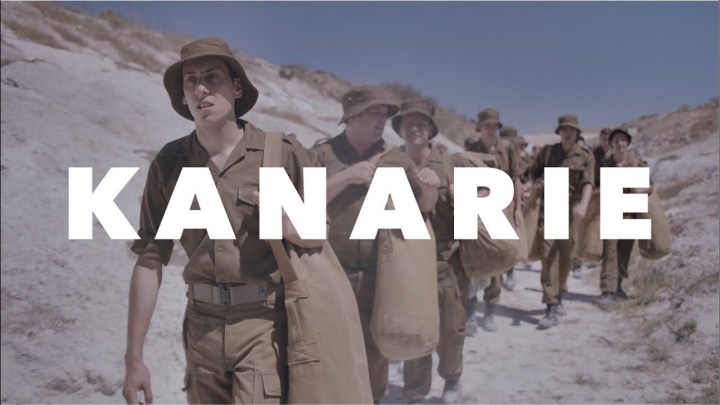FILM REVIEW
Kanarie – the redemptive power of music and finding solace in a violent white world

The South African film, Kanarie, which has opened countrywide, is not only about a group of young, mostly gay men who find themselves serving in the 1980s in the South African Defence Force Church Choir. It is also about the salvation music offers. God is, indeed, a DJ.
In his philosophical biography of German philosopher and poet Friedrich Nietzsche, German scholar Rüdiger Safranski recounts how Nietzsche had experienced music as an “authentic reality and colossal power”.
Nietzsche had travelled from Basel to Mannheim to listen to Wagner conducting his own music. Afterwards the philosopher was never the same. Something had shifted forever. Nietzsche had felt the notes “penetrate the core of his being”.
“Without music, life would be an error,” he wrote to his friend Erwin Rodhe.
Charl-Johan Lingenfelder is, by now, a veteran composer, conductor, arranger, musician, actor or whatever master of any medium he chooses to manifest his extraordinary creative range.
Lingenfelder has turned to scriptwriting this time round and is the author, alongside visionary director Christiaan Olwagen, of the layered and at times achingly funny (and equally achingly painful) script that cossets Kanarie.
The film is based on Lingenfelder’s time as a conscript in the SADF and as a member of the exclusive 23-member South African Defence Force Church Choir and Concert – commonly known as the Canaries, or in Afrikaans, Die Kanaries.
From the first notes of Bronski Beat’s Smalltown Boy, which arrive towards the end of the opening sequence of the film, Lingenfelder and Olwagen signal that not only will music be the creative and emotional scaffolding for the film, but also its foundation, its heart and a map for its interiority.
Dance too is a delicate thread that holds the narrative and Louisa Talbot’s choreography, in the magical scenes which play out – alongside the music – inside the head of the lead protagonist, Johan Niemand (Nobody), turn him and the film inside out.
Bezuidenhout, better known as a stand-up comedian, has proved himself in this film to be a luminous actor and an agile dancer.
Johan Niemand’s only salvation in his small Western Cape home town of Villiersdorp are his girl friends (not girlfriends) and his music, particularly Boy George and Culture Club. It is Boy George’s transgressive persona which captures Johan’s imagination and offers him the possibility of being different.
Music then begins its slow and persistent thread through the film. It is always close at hand, connecting the outside to the turbulent inside. Making visible the invisible.
Lingenfelder and Olwagen mine religious and folk music, like the deeply evocative Liewe Maan (an Afrikaans translation of the German lullaby Guter Mond, du gehst so stille) as well as classical music, opera and particularly late 1980s gay club and dance anthems.
These include songs by Boy George and Culture Club, Sade, Grace Jones, Billy Ocean, Bronski Beat, Pet Shop Boys, Madonna, Michael Jackson, Whitney Houston, Depeche Mode and South African acts Ballyhoo and Lesley Rae Dowling.
Those songs that do not pull you into the undertow are referred to by characters in the film, most of them outsiders, who have sought and found solace in music and the arts.
While a line of excruciatingly young white conscripts is herded into cavernous rooms, shouted at, shaved and rendered uniform, Johan Niemand becomes No 82419243BG, a Kanarie, stationed at the Valhalla base (Valhalla taken from Norse mythology and meaning “hall of the slain”).
And as we, the audience, watch this production-line transition of pimply, out-of-shape boys to shaven numbers, Beethoven’s Pathetique (which Johan played at his audition to get into the choir) soars above the scene juxtaposing the beauty of the music with the brutality of the moment.
Lingenfelder’s own haunting compositions too thread through the film, particularly the denouement where Johan must face what and who he is.
The slow bleed of what starts off as a sort of dirge and then blends and mixes with Boy George’s Do You Really Want to Hurt Me is searing in its beauty.
The palette of the film is bleached as if faded like an old Kodak colour print of the time. And indeed this is exactly what Olwagen recreates when he freezes the actors in various scenes so that they can look directly into the camera, as if posing for a still photograph.
So, while one layer of the film explores Johan’s awakening sexuality in a time of deep prejudice and intolerance, another is a surgical dissection of the deeply patriarchal and religious hierarchy of not only the National Party, but the Dutch Reformed Church’s role in justifying oppression, war and white supremacy.
The film exposes how propaganda can attempt to wipe clean the minds of those at whom it is aimed and who are expected to give their lives for its lies and manipulations. And it shows how music can act as a mental condom.
The overlay of the blossoming love between Johan and fellow conscript, Wolfgang Muller (Hannes Otto), a baritone, trumpeter and organist from Sasolburg, serves as a tender path to the film’s heart.
Olwagen and Lingenfelder have assembled an extraordinary cast who provide a faultless ensemble piece. These include Germandt Geldenhuys, who is pitch perfect as Ludlof, a portly, pink mommy’s boy, Mimi Coertze fan and budding opera singer who initially becomes a target of ridicule in the choir.
The towering Gerard Rudlolph, as the SADF NGK chaplain, Dominee Koch, is suitably menacing. A counterfoil to his rigidity is the gentle Dominee Engelbrecht (played by Jacques Bessenger), the choirmaster.
While the film plays off in this almost exclusive white’s man’s world, several memorable female characters are sprinkled throughout the film.
Veteran actress Anna-Mart van der Merwe plays the boozy and disillusioned Arlene Louw, wife of a wealthy Afrikaans husband. The couple entertains some of the choir members on tour at their home and this scene is one of the highlights of many highlights of the film.
Here Lingenfelder has chosen Ballyhoo’s hit, Man on The Moon, as Van Der Merwe’s character attempts to beguile the young men off the couch to dance. Arlene is the only female character in the film, who, because of her own disillusionment, offers Johan the consolation and truth he needs to ultimately face and be himself.
Other notable cameos are Tinarie van Wyk-Loots as Johan’s sister, Marilette, Martelize Kolver as his music teacher, Mrs Steenkamp, Lida Botha as the fussy and nosy Mrs Visser, who also offers the boys a room for the night while on tour, and Jennifer Steyn as the “English lady” who berates the conscripts for participating in an unjust war with black South Africans.
But the film ultimately belongs to Bezuidenhout. One of the most excruciating scenes is when Johann is offered a lift by a man who then sexually assaults him. The actor says nothing for most of the scene. A close-up of his face reveals the depth of his shame, confusion and rage.
From the décor to the costumes, to the painstaking attention to detail, including etchings of the Voortrekker Monument in Dominee Engelbrecht’s home and the doilies and knick-knacks, this film is faultless.
Kanarie is a gentle masterpiece which ultimately packs a powerful punch and begs us to ask questions about racism, toxic white masculinity, homophobia, self-loathing, acceptance, sexism, misogyny, religion and war.
At it’s heart is a heart – a heart filled with music and love. DM

















 Become an Insider
Become an Insider